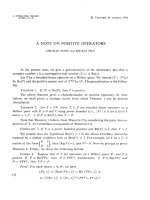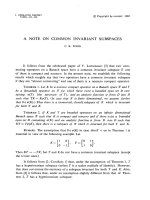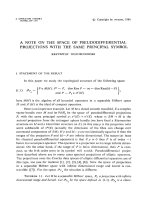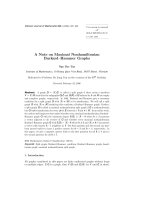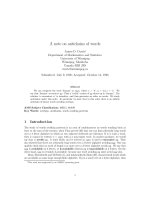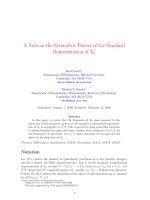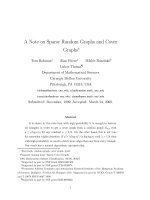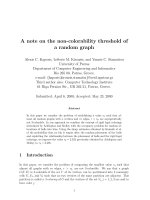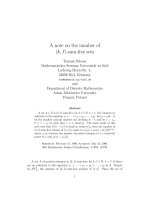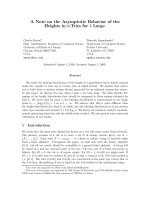Báo cáo toán học: "A Note on Maximal Nonhamiltonian Burkard–Hammer Graphs" pptx
Bạn đang xem bản rút gọn của tài liệu. Xem và tải ngay bản đầy đủ của tài liệu tại đây (204.03 KB, 13 trang )
Vietnam Journal of Mathematics 34:4 (2006) 397–409
A Note on Maximal Nonhamiltonian
Burkard–Hammer Graphs
Ngo Dac Tan
Institute of Mathematics, 18 Hoang Quoc Viet Road, 10307 Hanoi, Vietnam
Dedicated to Professor Do Long Van on the occasion of his 65
th
birthday
Received February 22, 2006
Abstract. Agraph
G =(V, E) is called a split graph if there exists a partition
V = I ∪K such that the subgraphs G[I] and G[K] of G induced by I and K are empty
and complete graphs, respectively. In 1980, Burkard and Hammer gave a necessary
condition for a spl it graph
G with |I| < |K| to be hamiltonian. We will call a split
graph
G with |I| < |K| satisfying this condition a Burkard–Hammer graph. Further,
a split graph
G is called a maximal nonhamiltonian split graph if G is nonhamiltonian
but
G+uv is hamiltonian for every uv ∈ E where u ∈ I and v ∈ K. In an earlier work,
the author and Iamjaroen have asked whether every maximal nonhamiltonian Burkard–
Hammer graph
G with the minimum degree δ(G) ≥|I|−k where k ≥ 3 possesses
a vertex adjacent to all vertices of
G and whether every maximal nonhamiltonian
Burkard–Hammer graph
G with δ(G)=|I|−k where k>3 and |I| >k+2 possesses
a vertex with exactly
k − 1 neigh bors in I. The first question and the second one have
been proved earlier to have a positive answer for
k =3and k =4, respectively. In
this paper, we give a negative answer both to the first question for all
k ≥ 4 and to
the second question for all
k ≥ 5.
2000 Mathematics Subject Classification: 05C45.
Keywords: Split graph, Burkar d–Hammer c ondition, Burkard–Hammer graph, hamil-
tonian graph, maximal nonhamiltonian split graph.
1. Introduction
All graphs considered in this paper are finite undirected graphs without loops
or multiple edges. If G is a graph, then V (G)andE(G)(orV and E in short)
398 Ngo Dac Tan
will denote its vertex-set and its edge-set, respectively. For a subset W ⊆ V (G),
the set of all neighbors of W is denoted by N
G
(W )orN (W )inshort. Fora
vertex v ∈ V (G), the degree of v, denoted by deg(v), is the number |N(v)|.The
minimum degree of G, denoted by δ(G), is the number min{deg(v) | v ∈ V (G)}.
By N
G,W
(v)orN
W
(v) in short we denote the set W ∩ N
G
(v). The subgraph
of G induced by W is denoted by G[W ]. Unless otherwise indicated, our graph-
theoretic terminology will follow [1].
AgraphG =(V,E) is called a split graph if there exists a partition V = I ∪K
such that the subgraphs G[I]andG[K]ofG induced by I and K are empty
and complete graphs, respectively. We will denote such a graph by S(I(G) ∪
K(G),E(G)) or S(I ∪ K, E) in short. Further, a split graph G = S(I ∪ K, E)is
called a complete split graph if every u ∈ I is adjacent to every v ∈ K. The notion
of split graphs was introduced in 1977 by F¨oldes and Hammer [4]. These graphs
are interesting because they are related to many problems in combinatorics (see
[3, 5, 10]) and in computer science (see [6, 7]).
In 1980, Burkard and Hammer gave a necessary condition for a split graph
G = S(I ∪K, E)with|I| < |K|
to be hamiltonian [2] (see Sec. 2 for more detail).
We will call this condition the Burkard–Hammer condition. Also, we will call a
split graph G = S(I ∪K, E)with|I| < |K|, which satisfies the Burkard–Hammer
condition, a Burkard–Hammer graph.
Thus, by [2] any hamiltonian split graph G = S(I ∪ K, E)with|I| < |K|
is a Burkard–Hammer graph. In general, the converse is not true. The first
nonhamiltonian Burkard–Hammer graph has been indicated in [2]. Further infi-
nite families of nonhamiltonian Burkard–Hammer graphs have been constructed
recently in [13].
A split graph G = S(I ∪ K, E) is called a maximal nonhamiltonian s plit
graph if G is nonhamiltonian but the graph G + uv is hamiltonian for every
uv ∈ E where u ∈ I and v ∈ K. It is known from a result in [12] that any
nonhamiltonian Burkard–Hammer graph is contained in a maximal nonhamil-
tonian Burkard–Hammer graph. So knowledge about maximal nonhamiltonian
Burkard–Hammer graphs provides us certain information about nonhamiltonian
Burkard–Hammer graphs.
It has been shown in [12] (see Theorem 2 in Sec. 2) that there are no non-
hamiltonian Burkard–Hammer graphs G = S(I ∪ K, E)withδ(G) ≥|I|−2and
no nonhamiltonian Burkard–Hammer graphs G = S(I∪K, E)with
δ(G)=|I|−3
and |I| > 5. Therefore, without loss of generality we may assume that all con-
sidered in this paper maximal nonhamiltonian Burkard–Hammer graphs G =
S(I ∪ K, E)haveδ(G)=|I|−k where |I|≥k ≥ 3 and all considered maximal
nonhamiltonian Burkard–Hammer graphs G = S(I ∪ K, E)withδ(G)=|I|−k
and |I| >k+2havek>3.
It has been proved recently in [14] that a maximal nonhamiltonian Burkard–
Hammer graph G = S(I ∪ K, E)withδ(G)=|I|−k where |I|≥k ≥ 3
must have |I|≥k + 2 and no vertices with exactly k +1, ,|I|−1neighbors
in I.Moreover,ifG = S(I ∪ K, E)hasδ(G)=|I|−k where k>3and
|I| >k+2,then G also has no vertices with exactly k neighbors in I. However,
it is shown in [14] that for every integer k>3 and every integer m>k+2 there
Note on Maximal Nonhamiltonian Burkard–Hammer Graphs 399
exists a maximal nonhamiltonian Burkard–Hammer graph G = S(I ∪ K, E)
with |I| = m and δ(G)=|I|−k which possesses a vertex with exactly k − 1
neighbors in I. Ngo Dac Tan and Iamjaroen have asked in [14] whether all
maximal nonhamiltonian Burkard–Hammer graphs G = S(I ∪K, E)withδ(G)=
|I|−k where k ≥ 3 possess a vertex adjacent to all vertices of G and whether
all maximal nonhamiltonian Burkard–Hammer graphs G = S(I ∪ K, E)with
δ(G)=|I|−k where k>3and|I| >k+ 2 possess a vertex with exactly k − 1
neighbors in I. The first question has been proved in [12] to have a positive
answer for k = 3. Recently, Ngo Dac Tan and Iamjaroen have proved in [14]
that the second question also has a positive answer for k =4. Inthispaper,
however, we will give a negative answer both to the first question for all k ≥ 4
and to the second question for all k ≥ 5.
We would like to note that there is an interesting discussion about the
Burkard–Hammer condition in [9]. Concerning the hamiltonian problem for
split graphs, the readers can see also [8] and [11].
2. Preliminaries
Let G = S(I ∪ K, E) be a split graph and I
⊆ I,K
⊆ K.DenotebyB
G
(I
∪
K
,E
) the graph G[I
∪ K
] − E(G[K
]). It is clear that G
= B
G
(I
∪ K
,E
)is
a bipartite graph with the bipartition subsets I
and K
. So we will call B
G
(I
∪
K
,E
)thebipartite subgr aph of G induced by I
and K
. For a component
G
j
= B
G
(I
j
∪ K
j
,E
j
)ofG
= B
G
(I
∪ K
,E
) we define
k
G
(G
j
)=k
G
(I
j
,K
j
)=
|I
j
|−|K
j
| if |I
j
| > | K
j
|,
0otherwise.
If G
= B
G
(I
∪ K
,E
)hasr components G
1
= B
G
(I
1
∪ K
1
,E
1
), ,G
r
=
B
G
(I
r
∪ K
r
,E
r
) then we define
k
G
(G
)=k
G
(I
,K
)=
r
j=1
k
G
(G
j
).
AcomponentG
j
= B
G
(I
j
∪ K
j
,E
j
)ofG
= B
G
(I
∪ K
,E
) is called a
T-component (resp., H-component, L-component)if|I
j
| > |K
j
| (resp., |I
j
| =
|K
j
|, |I
j
| < | K
j
|). Let h
G
(G
)=h
G
(I
,K
) denote the number of H-components
of G
.
In 1980, Burkard and Hammer proved the following necessary but not suffi-
cient condition for hamiltonian split graphs [2].
Theorem 1. [2] Let G = S(I ∪ K, E) be a split graph with |I| < |K|.IfG is
hamiltonian, then
k
G
(I
,K
)+max
1,
h
G
(I
,K
)
2
≤|N
G
(I
)|−|K
|
holds for all ∅ = I
⊆ I, K
⊆ N
G
(I
) with (k
G
(I
,K
),h
G
(I
,K
)) =(0, 0).
400 Ngo Dac Tan
We will shortly call the condition in Theorem 1 the Burkard–Hammer con-
dition. We also call a split graph G = S(I ∪ K, E)with|I| < |K|,which
satisfies the Burkard–Hammer condition, a Burkard–Hammer graph. Thus, by
Theorem 1 any hamiltonian split graph G = S(I ∪ K, E)with|I| < |K| is a
Burkard–Hammer graph. For split graphs G = S(I ∪ K, E)with|I| < |K| and
δ(G) ≥|I|−2 the converse is true [12]. But it is not true in general. The first
example of a nonhamiltonian Burkard–Hammer graph has been indicated in [2].
Recently, Tan and Hung [12] have classified nonhamiltonian Burkard–Hammer
graphs G = S(I ∪ K, E)withδ(G)=|I|−3. Namely, they have proved the
following result.
Theorem 2. [12] Let G = S(I ∪ K, E) be a split graph with |I| < |K
| and the
minimum degree δ(G) ≥|I|−3.Then
(i) If |I| =5then G has a Hamilton cycle if and only if G satisfies the Burkard–
Hammer condition;
(ii) If |I| =5and G satisfies the Burkard–Hammer condition, then G has no
Hamilton cycles i f and only if G is isomorphic to one of t he graphs H
1,n
,
H
2,n
, H
3,n
or H
4,n
listed in Table 1.
Table 1. The graphs H
1,n
,H
2,n
,H
3,n
and H
4,n
The graph The vertex-set The edge-set
G V (G)=I
∗
∪ K
∗
E(G)=E
∗
1
∪···∪E
∗
5
∪ E
∗
K
∗
H
1,n
I
∗
= {u
∗
1
,u
∗
2
,u
∗
3
,u
∗
4
,u
∗
5
}, E
∗
1
= {u
∗
1
v
∗
1
,u
∗
1
v
∗
2
},
(n>5) K
∗
= {v
∗
1
,v
∗
2
, , v
∗
n
}. E
∗
2
= {u
∗
2
v
∗
2
,u
∗
2
v
∗
4
},
E
∗
3
= {u
∗
3
v
∗
2
,u
∗
3
v
∗
3
,u
3
v
∗
6
},
E
∗
4
= {u
∗
4
v
∗
1
,u
∗
4
v
∗
4
,u
4
v
∗
6
},
E
∗
5
= {u
∗
5
v
∗
5
,u
∗
5
v
∗
6
},
E
∗
K
∗
= {v
∗
i
v
∗
j
| i = j; i, j =1, , n},
H
2,n
V (H
2,n
)=V (H
1,n
) E(H
2,n
)=E(H
1,n
) ∪{u
∗
4
v
∗
2
}
H
3,n
V (H
3,n
)=V (H
1,n
) E(H
3,n
)=E(H
1,n
) ∪{u
∗
5
v
∗
2
}
H
4,n
V (H
4,n
)=V (H
1,n
) E(H
4,n
)=E(H
1,n
) ∪{u
∗
4
v
∗
2
,u
∗
5
v
∗
2
}
Theorem 2 shows that there are only four nonhamiltonian Burkard–Hammer
graphs G = S(I ∪ K, E)withK = N(I)andδ(G)=|I|−3, namely, the
graphs H
1,6
,H
2,6
,H
3,6
and H
4,6
. In contrast with this result, the number of
nonhamiltonian Burkard–Hammer graphs G = S(I ∪ K, E)withK = N(I)and
δ(G)=|I|−4 is infinite. This is a recent result of Tan and Iamjaroen [13]. We
remind now one of the constructions in this work, which is needed for the next
sections.
Let G
1
= S(I
1
∪ K
1
,E
1
)andG
2
= S(I
2
∪ K
2
,E
2
) be split graphs with
V (G
1
) ∩ V (G
2
)=∅
Note on Maximal Nonhamiltonian Burkard–Hammer Graphs 401
and v be a vertex of K
1
.WesaythatagraphG is an expansion of G
1
by G
2
at
v if G is the graph obtained from (G
1
− v) ∪ G
2
by adding the set of edges
E
0
= {x
i
v
j
| x
i
∈ V (G
1
) \{v},v
j
∈ K
2
and x
i
v ∈ E
1
}.
It is clear that such a graph G is a split graph S(I ∪ K, E)withI = I
1
∪ I
2
,
K =(K
1
\{v})∪K
2
and is uniquely determined by G
1
,G
2
and v ∈ K
1
. Because
of this, we will denote this graph G by G
1
[G
2
,v]. Further, a graph G is called an
expansion of G
1
by G
2
if it is an expansion of G
1
by G
2
at some vertex v ∈ K
1
.
The following results which have been proved in [12 - 14] are needed later.
Lemma 1. [12] Let G = S(I ∪ K, E) be a Burkar d–Hammer graph. Then for
any uv ∈ E where u ∈ I and v ∈ K, the graph G+uv is also a Burkard–Hammer
graph.
Theorem 3. [13] Let G
1
= S(I
1
∪ K
1
,E
1
) be a Burkard–Hammer graph and
G
2
= S(I
2
∪ K
2
,E
2
) be a c omplete split graph with |I
2
| < |K
2
|.Thenany
expansion of G
1
by G
2
is a Burkard–Hammer graph.
Theorem 4. [13] Let G
1
= S(I
1
∪ K
1
,E
1
) be an arbitr ary split graph and
G
2
= S(I
2
∪ K
2
,E
2
) be a split graph with |K
2
| = | I
2
| +1. Then an expansion of
G
1
by G
2
is a hamiltonian gr aph if and only if both G
1
and G
2
are hamiltonian
graphs.
Let G = S(I ∪ K, E) be a split graph. Set
B
i
(G)={v ∈ K ||N
I
(v)| = i}.
If the graph G is clear from the context then we also write B
i
instead of
B
i
(G).
Theorem 5. [14] Let G
1
= S(I
1
∪ K
1
,E
1
) be a complete split graph with
|I
1
| < |K
1
| and G
2
= S(I
2
∪ K
2
,E
2
) be a maximal nonhamiltonian Burkard–
Hammer graph wi th δ(G
2
)=|I
2
|−k
2
such that every vertex u ∈ I
2
has N
G
2
(u) =
K
2
. Then any expansion G = S(I ∪ K, E)=G
1
[G
2
,v
1
] where v
1
∈ K
1
is a
maximal nonhamiltonian Burkard–Hammer graph with δ(G)=δ(G
2
)=|I|−
(k
2
+ |I
1
|). Moreover, for any x ∈ K
1
\{v
1
}, |N
G,I
(x)| = |I
1
| and for any
y ∈ K
2
, |N
G,I
(y)| = |N
G
2
,I
2
(y)| + |I
1
|.
3. Formulations of the Main Results and Discussions
By Theorem 2 in the previous section there are no nonhamiltonian Burkard–
Hammer graphs G = S(I ∪ K, E)withδ(G) ≥|I|−2 and no nonhamiltonian
Burkard–Hammer graphs G = S(I∪K, E)withδ(G)=|I|−3and| I| > 5. There-
fore, in further discussions without loss of generality we may assume that all
considered maximal nonhamiltonian Burkard–Hammer graphs G = S(I ∪ K, E)
with δ(G)=|I|−k have |I|≥k ≥ 3 and all considered maximal nonhamiltonian
Burkard–Hammer graphs G = S(I ∪ K, E)withδ(G)=|I|−k and |I| >k+2
have k>3. We start our discussions with the following result proved in [14].
402 Ngo Dac Tan
Theorem 6. [14] Let G = S(I ∪ K, E) be a maximal nonhamiltonian Burkard–
Hammer graph with the minimum degree δ(G)=|I|−k where |I|≥k ≥ 3.Then
|I|≥k +2 and B
k+1
= ···= B
|I|−1
= ∅.Furthermore,ifk>3 and |I| >k+2
then B
k
is also empty.
Two questions raised from Theorem 6 are whether a maximal nonhamiltonian
Burkard–Hammer graph G = S(I ∪ K, E)withδ(G)=|I|−k where k ≥ 3must
have B
|I|
= ∅ and whether a maximal nonhamiltonian Burkard–Hammer graph
G = S(I ∪ K, E)withδ(G)=|I|−k where k>3and|I| >k+ 2 also must have
B
k−1
= ∅. The following results proved in [14] show that both these questions
have negative answers.
Theorem 7. [14]
(a) For every integer k ≥ 3 there exists a maximal nonhamiltonian Burkard–
Hammer graph G = S(I ∪ K, E) with |I| = k +2 and δ(G)=|I|−k,which
has B
k
= ∅ and B
|I|
= ∅.
(b) For every integer k>3 and every integer m>k+2 ther e exists a maximal
nonhamiltonian Burkard–Hammer graph G = S(I ∪ K, E) with | I| = m and
δ(G)=|I|−k, which has B
k−1
(G) = ∅ and B
|I|
= ∅.
Two natural questions raised from the results in Theorem 7 are whether every
maximal nonhamiltonian Burkard–Hammer graph G = S(I ∪ K, E)withδ(G)=
|I|−k where k ≥ 3hasB
|I|
= ∅ and whether every maximal nonhamiltonian
Burkard–Hammer graph G = S(I ∪ K, E)withδ(G)=|I|−k where k>3and
|I| >k+2has B
k−1
= ∅. These questions have been posed in [14]. Theorem
2 shows that the first question has a positive answer for k = 3 and Theorem 8
below proved in [14] shows that the second question has a positive answer for
k = 4. These make the questions more attractive for investigation.
Theorem 8. [14] Let G = S(I ∪ K, E) be a maximal nonhamiltonian Burkard–
Hammer graph with |I|≥7 and the minimum degree δ(G)=|I|−4.Then
B
4
= B
5
= ···= B
|I|−1
= ∅ but B
3
= ∅.
In this paper, we get complete answers to the above two questions. Namely,
we will prove the following results.
Theorem 9.
(a) For every integer k ≥ 4 there exists a maximal nonhamiltonian Burkard–
Hammer graph G = S(I ∪ K, E) with δ(G)=|I|−k, which has B
|I|
= ∅.
(a) For every integer k ≥ 5 and every integer m>k+2 there exists a maximal
nonhamiltonian Burkard–Hammer graph G = S(I ∪ K, E) with |I| = m and
δ(G)=|I|−k, which has B
k−1
= ∅ but B
k−2
= ∅,B
k−3
= ∅ and B
k−4
= ∅.
Thus, by Theorem 9 both the first question for all k ≥ 4 and the second
question for all k ≥ 5 have negative answers, although the former question has
a positive answer for k = 3 and the latter one has a positive answer for k =4.
Note on Maximal Nonhamiltonian Burkard–Hammer Graphs 403
4. Pro of of Theorem 9
First of all we prove the following lemmas.
Lemma 2. Let L = S(I(L) ∪ K(L),E(L)) be the split graph with
I(L)={u
∗
1
,u
∗
2
, ,u
∗
6
},
K(L)={v
∗
1
,v
∗
2
, ,v
∗
7
},
E(L)=E
∗
1
∪ E
∗
2
∪···∪E
∗
6
∪ E
∗
K
,
where
E
∗
1
= {u
∗
1
v
∗
1
,u
∗
1
v
∗
2
,u
∗
1
v
∗
3
},
E
∗
2
= {u
∗
2
v
∗
2
,u
∗
2
v
∗
4
},
E
∗
3
= {u
∗
3
v
∗
3
,u
∗
3
v
∗
4
,u
∗
3
v
∗
6
},
E
∗
4
= {u
∗
4
v
∗
1
,u
∗
4
v
∗
4
,u
∗
4
v
∗
7
},
E
∗
5
= {u
∗
5
v
∗
2
,u
∗
5
v
∗
5
,u
∗
5
v
∗
7
},
E
∗
6
= {u
∗
6
v
∗
3
,u
∗
6
v
∗
7
},
E
∗
K
= {v
∗
i
v
∗
j
| i = j; i, j ∈{1, ,7}}
(see Fig. 1). Then L is a maximal nonhamiltonian Burkard–Hammer graph with
B
|I(L)|
= ∅.
Fig. 1. The graph L
Table 2. The Hamilton cycle for L − u
∗
i
Graph L − u
∗
i
Hamilton cycle C
u
∗
i
for L − u
∗
i
L − u
∗
1
C
u
∗
1
= u
∗
2
v
∗
2
u
∗
5
v
∗
5
v
∗
3
u
∗
6
v
∗
7
u
∗
4
v
∗
1
v
∗
6
u
∗
3
v
∗
4
u
∗
2
L − u
∗
2
C
u
∗
2
= u
∗
1
v
∗
1
u
∗
4
v
∗
4
u
∗
3
v
∗
6
v
∗
2
v
∗
5
u
∗
5
v
∗
7
u
∗
6
v
∗
3
u
∗
1
L − u
∗
3
C
u
∗
3
= u
∗
1
v
∗
2
u
∗
2
v
∗
4
u
∗
4
v
∗
1
v
∗
6
v
∗
5
u
∗
5
v
∗
7
u
∗
6
v
∗
3
u
∗
1
L − u
∗
4
C
u
∗
4
= u
∗
1
v
∗
1
v
∗
3
u
∗
6
v
∗
7
u
∗
5
v
∗
5
v
∗
6
u
∗
3
v
∗
4
u
∗
2
v
∗
2
u
∗
1
L − u
∗
5
C
u
∗
5
= u
∗
1
v
∗
1
u
∗
4
v
∗
7
u
∗
6
v
∗
3
v
∗
5
v
∗
6
u
∗
3
v
∗
4
u
∗
2
v
∗
2
u
∗
1
L − u
∗
6
C
u
∗
6
= u
∗
1
v
∗
1
u
∗
4
v
∗
7
u
∗
5
v
∗
5
v
∗
3
v
∗
6
u
∗
3
v
∗
4
u
∗
2
v
∗
2
u
∗
1
404 Ngo Dac Tan
Proof. For any vertex u
∗
i
∈ I(L), the graph L − u
∗
i
has a Hamilton cycle C
u
∗
i
which is shown in Table 2. Therefore, by Theorem 1 the Burkard–Hammer
condition holds for any ∅ = I
⊆ I(L)andK
⊆ N
L
(I
)with|I
|≤5and
(k(I
,K
),h(I
,K
)) =(0, 0). For I
= I(L)andK
⊆ N
L
(I(L)), by direct
computations we can verify that the Burkard–Hammer condition also holds. (It
is tedious to do this, but we don’t know other ways to verify the last assertion.)
Thus, L satisfies the Burkard–Hammer condition.
Now suppose that L has a Hamilton cycle C.Sincedeg(u
∗
2
)=deg(u
∗
6
)=2,C
must contain the paths v
∗
2
u
∗
2
v
∗
4
and v
∗
3
u
∗
6
v
∗
7
. We consider separately the following
possibilities for C:
(i) v
∗
2
u
∗
1
v
∗
3
is in C.
In this case C must contain the path v
∗
4
u
∗
2
v
∗
2
u
∗
1
v
∗
3
u
∗
6
v
∗
7
.Sobothv
∗
2
u
∗
5
and
v
∗
3
u
∗
3
cannot be in C. Therefore, v
∗
5
u
∗
5
v
∗
7
and v
∗
4
u
∗
3
v
∗
6
must be in C because
deg(u
∗
3
)=deg(u
∗
5
) = 3. It follows that both u
∗
4
v
∗
4
and u
∗
4
v
∗
7
cannot be in C.
Hence, u
∗
4
is not in C because deg(u
∗
4
) = 3, contradicting our assumption that
C is a Hamilton cycle of L. Thus, this case cannot occur.
(ii) v
∗
1
u
∗
1
v
∗
2
is in C.
In this case, C must contain the path v
∗
1
u
∗
1
v
∗
2
u
∗
2
v
∗
4
. Therefore, v
∗
2
u
∗
5
cannot
be in C.Sincedeg(u
∗
5
)=3,v
∗
5
u
∗
5
v
∗
7
must be in C. It follows that v
∗
7
u
∗
4
cannot
be in C because v
∗
7
u
∗
5
and v
∗
7
u
∗
6
are already in C.So,v
∗
1
u
∗
4
v
∗
4
must be in C
because deg(u
∗
4
)=3. Thus,v
∗
1
u
∗
1
v
∗
2
u
∗
2
v
∗
4
u
∗
4
v
∗
1
is a proper subcycle of C,whichis
impossible. This means that this case also cannot occur.
(iii) v
∗
1
u
∗
1
v
∗
3
is in C.
By arguments similar to those of Case (ii), we can get a contradiction for
this case. Hence, this case also cannot occur.
Thus, the assumption that L has a Hamilton cycle is false. So L must be
nonhamiltonian.
Now we prove that L is a maximal nonhamiltonian split graph. Since L is
nonhamiltonian as we have proved above, it remains to prove that L + u
∗
i
v
∗
j
is
hamiltonian for any u
∗
i
v
∗
j
∈ E(L)whereu
∗
i
∈ I(L)andv
∗
j
∈ K(L). This is done
in Table 3.
Finally, the fact that B
|I(L)|
= ∅ is trivial. The proof of Lemma 2 is complete.
Lemma 3. Let H
4,6
be a graph defined in Table 1 and X = S(I(X)∪K(X),E(X))
be the complete split graph with I(X)={u
x,1
} and K(X)={v
x,1
,v
x,2
}.Then
the g raph
T = S(I(T ) ∪ K(T ),E(T )) = H
4,6
[X, v
∗
1
]+u
x,1
v
∗
2
(see Fig. 2) is a maximal nonhamiltonian Burkard–Hammer graph with B
4
(T )=
∅ but B
3
(T ) = ∅,B
2
(T ) = ∅ and B
1
(T ) = ∅.
Proof. The following assertions (a) and (b) are true for T .
Note on Maximal Nonhamiltonian Burkard–Hammer Graphs 405
Table 3. The Hamilton cycle for L + u
∗
i
v
∗
j
Graph L + u
∗
i
v
∗
j
Hamilton cycle C
u
∗
i
v
∗
j
for L + u
∗
i
v
∗
j
L + u
∗
1
v
∗
4
C
u
∗
1
v
∗
4
= u
∗
1
v
∗
1
u
∗
4
v
∗
7
u
∗
6
v
∗
3
u
∗
3
v
∗
6
v
∗
5
u
∗
5
v
∗
2
u
∗
2
v
∗
4
u
∗
1
L + u
∗
1
v
∗
5
C
u
∗
1
v
∗
5
= u
∗
1
v
∗
1
u
∗
4
v
∗
4
u
∗
2
v
∗
2
u
∗
5
v
∗
7
u
∗
6
v
∗
3
u
∗
3
v
∗
6
v
∗
5
u
∗
1
L + u
∗
1
v
∗
6
C
u
∗
1
v
∗
6
= u
∗
1
v
∗
1
u
∗
4
v
∗
4
u
∗
2
v
∗
2
u
∗
5
v
∗
5
v
∗
7
u
∗
6
v
∗
3
u
∗
3
v
∗
6
u
∗
1
L + u
∗
1
v
∗
7
C
u
∗
1
v
∗
7
= u
∗
1
v
∗
1
u
∗
4
v
∗
4
u
∗
2
v
∗
2
u
∗
5
v
∗
5
v
∗
6
u
∗
3
v
∗
3
u
∗
6
v
∗
7
u
∗
1
L + u
∗
2
v
∗
1
C
u
∗
2
v
∗
1
= u
∗
1
v
∗
1
u
∗
2
v
∗
4
u
∗
4
v
∗
7
u
∗
6
v
∗
3
u
∗
3
v
∗
6
v
∗
5
u
∗
5
v
∗
2
u
∗
1
L + u
∗
2
v
∗
3
C
u
∗
2
v
∗
3
= u
∗
1
v
∗
1
u
∗
4
v
∗
4
u
∗
3
v
∗
6
v
∗
5
u
∗
5
v
∗
7
u
∗
6
v
∗
3
u
∗
2
v
∗
2
u
∗
1
L + u
∗
2
v
∗
5
C
u
∗
2
v
∗
5
= u
∗
1
v
∗
1
u
∗
4
v
∗
4
u
∗
2
v
∗
5
v
∗
6
u
∗
3
v
∗
3
u
∗
6
v
∗
7
u
∗
5
v
∗
2
u
∗
1
L + u
∗
2
v
∗
6
C
u
∗
2
v
∗
6
= u
∗
1
v
∗
1
u
∗
4
v
∗
4
u
∗
3
v
∗
3
u
∗
6
v
∗
7
u
∗
5
v
∗
5
v
∗
6
u
∗
2
v
∗
2
u
∗
1
L + u
∗
2
v
∗
7
C
u
∗
2
v
∗
7
= u
∗
1
v
∗
1
u
∗
4
v
∗
4
u
∗
2
v
∗
7
u
∗
6
v
∗
3
u
∗
3
v
∗
6
v
∗
5
u
∗
5
v
∗
2
u
∗
1
L + u
∗
3
v
∗
1
C
u
∗
3
v
∗
1
= u
∗
1
v
∗
2
u
∗
2
v
∗
4
u
∗
4
v
∗
1
u
∗
3
v
∗
6
v
∗
5
u
∗
5
v
∗
7
u
∗
6
v
∗
3
u
∗
1
L + u
∗
3
v
∗
2
C
u
∗
3
v
∗
2
= u
∗
1
v
∗
1
u
∗
4
v
∗
4
u
∗
2
v
∗
2
u
∗
3
v
∗
6
v
∗
5
u
∗
5
v
∗
7
u
∗
6
v
∗
3
u
∗
1
L + u
∗
3
v
∗
5
C
u
∗
3
v
∗
5
= u
∗
1
v
∗
1
u
∗
4
v
∗
4
u
∗
2
v
∗
2
v
∗
6
u
∗
3
v
∗
5
u
∗
5
v
∗
7
u
∗
6
v
∗
3
u
∗
1
L + u
∗
3
v
∗
7
C
u
∗
3
v
∗
7
= u
∗
1
v
∗
1
u
∗
4
v
∗
4
u
∗
2
v
∗
2
u
∗
5
v
∗
5
v
∗
6
u
∗
3
v
∗
7
u
∗
6
v
∗
3
u
∗
1
L + u
∗
4
v
∗
2
C
u
∗
4
v
∗
2
= u
∗
1
v
∗
1
u
∗
4
v
∗
2
u
∗
2
v
∗
4
u
∗
3
v
∗
6
v
∗
5
u
∗
5
v
∗
7
u
∗
6
v
∗
3
u
∗
1
L + u
∗
4
v
∗
3
C
u
∗
4
v
∗
3
= u
∗
1
v
∗
1
u
∗
4
v
∗
3
u
∗
6
v
∗
7
u
∗
5
v
∗
5
v
∗
6
u
∗
3
v
∗
4
u
∗
2
v
∗
2
u
∗
1
L + u
∗
4
v
∗
5
C
u
∗
4
v
∗
5
= u
∗
1
v
∗
1
u
∗
4
v
∗
5
u
∗
5
v
∗
2
u
∗
2
v
∗
4
u
∗
3
v
∗
6
v
∗
7
u
∗
6
v
∗
3
u
∗
1
L + u
∗
4
v
∗
6
C
u
∗
4
v
∗
6
= u
∗
1
v
∗
1
u
∗
4
v
∗
6
v
∗
5
u
∗
5
v
∗
7
u
∗
6
v
∗
3
u
∗
3
v
∗
4
u
∗
2
v
∗
2
u
∗
1
L + u
∗
5
v
∗
1
C
u
∗
5
v
∗
1
= u
∗
1
v
∗
1
u
∗
5
v
∗
5
v
∗
6
u
∗
3
v
∗
3
u
∗
6
v
∗
7
u
∗
4
v
∗
4
u
∗
2
v
∗
2
u
∗
1
L + u
∗
5
v
∗
3
C
u
∗
5
v
∗
3
= u
∗
1
v
∗
1
u
∗
4
v
∗
7
u
∗
6
v
∗
3
u
∗
5
v
∗
5
v
∗
6
u
∗
3
v
∗
4
u
∗
2
v
∗
2
u
∗
1
L + u
∗
5
v
∗
4
C
u
∗
5
v
∗
4
= u
∗
1
v
∗
1
u
∗
4
v
∗
7
u
∗
6
v
∗
3
u
∗
3
v
∗
6
v
∗
5
u
∗
5
v
∗
4
u
∗
2
v
∗
2
u
∗
1
L + u
∗
5
v
∗
6
C
u
∗
5
v
∗
6
= u
∗
1
v
∗
1
u
∗
4
v
∗
7
u
∗
6
v
∗
3
v
∗
5
u
∗
5
v
∗
6
u
∗
3
v
∗
4
u
∗
2
v
∗
2
u
∗
1
L + u
∗
6
v
∗
1
C
u
∗
6
v
∗
1
= u
∗
1
v
∗
1
u
∗
6
v
∗
3
u
∗
3
v
∗
6
v
∗
5
u
∗
5
v
∗
7
u
∗
4
v
∗
4
u
∗
2
v
∗
2
u
∗
1
L + u
∗
6
v
∗
2
C
u
∗
6
v
∗
2
= u
∗
1
v
∗
1
u
∗
4
v
∗
7
u
∗
5
v
∗
5
v
∗
6
u
∗
3
v
∗
4
u
∗
2
v
∗
2
u
∗
6
v
∗
3
u
∗
1
L + u
∗
6
v
∗
4
C
u
∗
6
v
∗
4
= u
∗
1
v
∗
1
u
∗
4
v
∗
7
u
∗
5
v
∗
5
v
∗
6
u
∗
3
v
∗
3
u
∗
6
v
∗
4
u
∗
2
v
∗
2
u
∗
1
L + u
∗
6
v
∗
5
C
u
∗
6
v
∗
5
= u
∗
1
v
∗
1
u
∗
4
v
∗
4
u
∗
2
v
∗
2
u
∗
5
v
∗
7
u
∗
6
v
∗
5
v
∗
6
u
∗
3
v
∗
3
u
∗
1
L + u
∗
6
v
∗
6
C
u
∗
6
v
∗
6
= u
∗
1
v
∗
1
u
∗
4
v
∗
7
u
∗
6
v
∗
6
v
∗
5
u
∗
5
v
∗
2
u
∗
2
v
∗
4
u
∗
3
v
∗
3
u
∗
1
406 Ngo Dac Tan
Fig. 2. The graph T
(a) T is a Burkard–Hammer graph.
In fact, since H
4,6
is a Burkard–Hammer graph, by Theorem 3 the graph
H
4,6
[X, v
∗
1
] is a Burkard–Hammer graph. Therefore, by Lemma 1 the graph T
is a Burkard–Hammer graph.
(b) T is a maximal nonhamiltonian split gr aph.
Since H
4,6
is nonhamiltonian, by Theorem 4 the graph H
4,6
[X, v
∗
1
]isnon-
hamiltonian. Therefore, if T has a Hamilton cycle C then C must contain the
edge u
x,1
v
∗
2
.SoC must contain the path u
x,1
v
∗
2
u
∗
2
v
∗
4
because N
T
(u
∗
2
)={v
∗
2
,v
∗
4
}.
It follows that the edges u
∗
1
v
∗
2
,u
∗
3
v
∗
2
,u
∗
5
v
∗
2
are not in C. Hence, C must contain
the paths v
x,1
u
∗
1
v
x,2
and v
∗
3
u
∗
3
v
∗
6
u
∗
5
v
∗
5
because u
∗
1
,u
∗
3
and u
∗
5
have degree 3 in
T . From these facts we see that both u
∗
4
v
∗
2
and u
∗
4
v
∗
6
cannot be in C.Nowif
u
x,1
v
x,1
is in C then u
∗
4
v
x,1
also cannot be in C because the edges u
x,1
v
x,1
and
u
∗
1
v
x,1
are already in C. Therefore C
1
= u
x,1
v
∗
2
u
∗
2
v
∗
4
u
∗
4
v
x,2
u
∗
1
v
x,1
u
x,1
is a proper
subcycle of C, a contradiction. Similarly, if u
x,1
v
x,2
is in C then u
∗
4
v
x,2
cannot
be in C and therefore C
2
= u
x,1
v
∗
2
u
∗
2
v
∗
4
u
∗
4
v
x,1
u
∗
1
v
x,2
u
x,1
is a proper subcycle of
C, a contradiction again. Thus, T must be nonhamiltonian.
To prove Assertion (b) it remains to prove that T + uv is hamiltonian for
every uv ∈ E(T )whereu ∈ I(T )andv ∈ K(T ).
First suppose that u ∈ I
∗
and v ∈ K
∗
\{v
∗
1
}.Thenuv also is not an edge
of H
4,6
.SinceH
4,6
is a maximal nonhamiltonian split graph by Theorem 2, the
graph H
4,6
+ uv is hamiltonian. Therefore, (H
4,6
+ uv)[X, v
∗
1
] is hamiltonian by
Theorem 4 because the graph X trivially has a Hamilton cycle. It is clear that
in this case T + uv =(H
4,6
+ uv)[X, v
∗
1
]+u
x,1
v
∗
2
. Hence, T + uv is hamiltonian
if u ∈ I
∗
and v ∈ K
∗
\{v
∗
1
}.
Next suppose that u ∈ I
∗
and v ∈{v
x,1
,v
x,2
}.Thenu is not adjacent to v
∗
1
in H
4,6
.SinceH
4,6
is a maximal nonhamiltonian split graph, H
4,6
+ uv
∗
1
has
a Hamilton cycle C containing the edge uv
∗
1
. Now it is not difficult to see that
if v = v
x,1
(resp., v = v
x,2
) then we can get a Hamilton cycle for T + uv by
replacing the vertex v
∗
1
in C with the path v
x,1
u
x,1
v
x,2
(resp., v
x,2
u
x,1
v
x,1
).
Finally suppose that u = u
x,1
and v is one of the vertices v
∗
3
,v
∗
4
,v
∗
5
or v
∗
6
.
Then
C
3
= u
x,1
v
∗
3
u
∗
3
v
∗
6
u
∗
5
v
∗
5
v
∗
2
u
∗
2
v
∗
4
u
∗
4
v
x,2
u
∗
1
v
x,1
u
x,1
,
C
4
= u
x,1
v
∗
4
u
∗
2
v
∗
2
u
∗
3
v
∗
3
v
∗
5
u
∗
5
v
∗
6
u
∗
4
v
x,2
u
∗
1
v
x,1
u
x,1
,
Note on Maximal Nonhamiltonian Burkard–Hammer Graphs 407
C
5
= u
x,1
v
∗
5
u
∗
5
v
∗
6
u
∗
3
v
∗
3
v
∗
2
u
∗
2
v
∗
4
u
∗
4
v
x,2
u
∗
1
v
x,1
u
x,1
and
C
6
= u
x,1
v
∗
6
u
∗
5
v
∗
5
v
∗
3
u
∗
3
v
∗
2
u
∗
2
v
∗
4
u
∗
4
v
x,2
u
∗
1
v
x,1
u
x,1
are Hamilton cycles of T + u
x,1
v
∗
3
,T+ u
x,1
v
∗
4
,T+ u
x,1
v
∗
5
and T + u
x,1
v
∗
6
, respec-
tively.
Thus, T is a maximal nonhamiltonian split graph.
By Assertions (a) and (b) the graph T = S(I(T )∪K(T ),E(T )) = H
4,6
[X, v
∗
1
]
+u
x,1
v
∗
2
is a maximal nonhamiltonian Burkard–Hammer graph. Furthermore, it
is clear that B
4
(T )=∅ but B
3
(T ) = ∅,B
2
(T ) = ∅ and B
1
(T ) = ∅.
The proof of Lemma 12 is complete.
Lemma 4. Let T = S(I(T ) ∪ K(T ),E(T )) be the maximal nonhamiltonian
Burkard–Hammer gr aph constructed in Lemma 3 and Y
t
= S(I(Y
t
)∪K(Y
t
),E(Y
t
))
be a complete split graph with I(Y
t
) = {u
y,1
,u
y,2
, , u
y,t
} and K(Y
t
)={v
y,1
,
v
y,2
, , v
y,t
,v
y,t+1
} where t ≥ 1 is an integer. Then the graph H
t
= S(I(H
t
) ∪
K(H
t
),E(H
t
)) = T [Y
t
,v
∗
2
] is a maximal nonhamiltonian Burkard–Hammer gr aph
with |I(H
t
)| =6+t, δ(H
t
)=t +1 = |I(H
t
)|−5. Moreover, B
4
(H
t
)=∅ but
B
3
(H
t
) = ∅,B
2
(H
t
) = ∅ and B
1
(H
t
) = ∅.
Proof. By Lemma 3, graph T is a nonhamiltonian Burkard–Hammer graph.
Therefore, by Theorems 3 and 4, the graph H
t
is a nonhamiltonian Burkard–
Hammer graph. We prove now that H
t
+uv is hamiltonian for every uv ∈ E(H
t
)
where u ∈ I(H
t
)andv ∈ K(H
t
). There are two separate cases to consider.
Case 1: u ∈ I(T ),v ∈ K(T ) \{v
∗
2
}.
In this case, uv ∈ E(T )andH
t
+ uv =(T + uv)[Y
t
,v
∗
2
]. Since T is a
maximal nonhamiltonian Burkard–Hammer graph by Lemma 3, the graph T +uv
is hamiltonian. The graph Y
t
= S(I(Y
t
) ∪ K(Y
t
),E(Y
t
)) is also hamiltonian
because it is a complete split graph with |K(Y
t
)| = |I(Y
t
)| + 1. By Theorem 4,
the graph (T + uv)[Y
t
,v
∗
2
] has a Hamilton cycle. Hence, the graph H
t
+ uv is
hamiltonian.
Case 2: u ∈ I(Y
t
),v ∈ K(T ) \{v
∗
2
}.
Since v ∈ K(T ) \{v
∗
2
},wehave|N
I(T )
(v)|≤3. Therefore, there exists a
vertex w ∈ I(T ) such that wv ∈ E(T ). By Case 1, the graph H
t
+ wv has a
Hamilton cycle C which must contain the edge wv because H
t
is nonhamiltonian.
Let
−→
C be the cycle C with an orientation. By
←−
C we denote the cycle C with the
reverse orientation. If x, y ∈ V (C), then x
−→
Cydenotes the consecutive vertices of
C from x to y in the direction specified by
−→
C . The same vertices in the reverse
order are given by y
←−
Cx.Ifx ∈ V (C)thenx
+
denotes the successor of x on
−→
C ,andx
−
denotes its predecessor. Without loss of generality, we may assume
that w
+
= v in
−→
C . By the definitions of T and T [Y
t
,v
∗
2
], vertex w is adjacent to
both u
+
and u
−
. Therefore, C
= v
−→
Cu
−
w
−→
Cuv is a Hamilton cycle in H
t
+ uv.
Thus, H
t
+ uv is hamiltonian for every uv ∈ E(H
t
)whereu ∈ I(H
t
)and
v ∈ K(H
t
). Therefore, H
t
is a maximal nonhamiltonian split graph. Further,
we have
|I(H
t
)| = |I(T )| + |I(Y
t
)| =6+t,
408 Ngo Dac Tan
δ(H
t
)=|K(Y
t
)| = t +1=|I(H
t
)|−5.
It is also clear that B
4
(H
t
)=∅ but B
3
(H
t
) = ∅,B
2
(H
t
) = ∅ and B
1
(H
t
) = ∅.
The proof of Lemma 4 is complete.
ProofofTheorem9.
(a) Let k = 4. Then the graph L = S(I(L) ∪ K(L),E(L)) of Lemma 2 is a
maximal nonhamiltonian Burkard–Hammer graph with δ(L)=2=|I(L)|−4
and B
|I(L)|
= ∅. Thus, Assertion (a) is true for k =4.
Now suppose that k>4. Let G
1
= S(I
1
∪ K
1
,E
1
) be a complete split graph
with |K
1
| > | I
1
| = k−4andv be a vertex of K
1
.SincethegraphL of Lemma 2 is
a maximal nonhamiltonian Burkard–Hammer graph which has N
L
(u) = K(L)
for every u ∈ I(L), by Theorem 6 the graph G = S(I ∪ K, E)=G
1
[L, v]
is a maximal nonhamiltonian Burkard–Hammer graph with δ(G)=δ(L)=
|I|−(4 +|I
1
|)=|I|−k. Moreover, by Theorem 5 and Lemma 2, B
|I|
= ∅.Thus,
Assertion (a) is also true for k>4.
(b) Let k =5andm be an integer with m>7. Further, let H
t
= T [Y
t
,v
∗
2
]bea
graph constructed from T and Y
t
with |I(Y
t
)| = t = m − 6 as in Lemma 4. Then
by this lemma, the graph H
t
is a maximal nonhamiltonian Burkard–Hammer
graph with |I(H
t
)| = |I(T )| +|I(Y
t
)| =6+(m −6) = m and δ(H
t
)=|I(H
t
)|−5.
Also by Lemma 4, B
4
(H
t
)=∅ but B
3
(H
t
) = ∅,B
2
(H
t
) = ∅ and B
1
(H
t
) = ∅.
Thus, Assertion (b) is true for k = 5 and any integer m>7.
Now suppose that k and m are integers with k ≥ 6andm>k+2. Let
G
1
= S(I
1
∪ K
1
,E
1
) be a complete split graph with |K
1
| > |I
1
| = k − 5andv
be a vertex of K
1
. Further, let G
2
= S(I
2
∪ K
2
,E
2
) be the graph H
l
= T [Y
l
,v
∗
2
]
defined in Lemma 4 where l = m − k − 1. Then by Lemma 4, the graph
G
2
is a maximal nonhamiltonian Burkard–Hammer graph with |I
2
| = | I(H
l
)| =
m−k+5,δ(G
2
)=δ(H
l
)=|I(G
2
)|−5andB
4
(G
2
)=∅ but B
3
(G
2
) = ∅,B
2
(G
2
) =
∅,B
1
(G
2
) = ∅. Moreover, it is clear that for every vertex u ∈ I
2
, N
G
2
(u) = K
2
.
Therefore, by Theorem 6 the graph G = S(I ∪ K, E)=G
1
[G
2
,v] is a maximal
nonhamiltonian Burkard–Hammer graph. Further, we have |I| = |I
1
| + |I
2
| =
(k − 5) + (m − k +5)=m and by Theorem 5 and Lemma 4
δ(G)=δ(G
2
)=|I|−(5 + |I
1
|)=|I|−k,
B
k−1
(G)=B
4+|I
1
|
(G)=∅,
B
k−2
(G)=B
3+|I
1
|
(G) = ∅,
B
k−2
(G)=B
2+|I
1
|
(G) = ∅ and
B
k−4
(G)=B
1+|I
1
|
(G) = ∅.
Thus, Assertion (b) is also true for any k ≥ 6andm>k+2.
The proof of Theorem 10 is complete.
References
1. M. Behzad and G. Chartrand, Introduction to the Theory of Graphs, Allyn and
Bacon, Boston, 1971.
Note on Maximal Nonhamiltonian Burkard–Hammer Graphs 409
2. R. E. Burkard and P. L. Hammer, A note on hamiltonian split graphs,
J. Combin.
Theory Ser. B
28 (1980) 245–248.
3. V. Chv´atal and P. L. Hammer, Aggregation o f inequalities in integer programming,
Ann. Discrete Math. 1 (1977 ) 145–162.
4. S. F¨oldes and P. L. Hammer, Split graphs, In: Pr oceedings of the Eighth South-
eastern Conference on Combinatorics, Graph Theory and Computing (Louisiana
State Univ., Baton Rouge, La, 1977) pp. 311–315. Congressus Numerantium, No
XIX, Utilitas Math., Winnipeg, Man., 1977.
5. S. F¨oldes and P. L. Hammer, On a class of matroid-producing graphs, In: Combi-
natorics (Proc. Fifth Hungarian Colloq., K eszthely (1976), Vol. 1, 331–352, Col-
loq.Math.Soc.Jan´os Bolyai 18, North-Holland, Amsterdam-NewYork, 1978.
6. P. B. Henderson and Y. Zalcstein, A graph-theoretic characterization of the
PV
chunk
class of synchronizing primitive, SIAM J. Computing 6 (1977) 88–108.
7. A. H. Hesham and El. R. Hesham, Task allocation in distributed systems: a split
graph model, J. Combin. Math. Combin. Comput. 14 (1993) 15–32.
8. D. Kratsc h, J. Lehel, and H . M¨uller, Toughness, hamiltonicity and split graphs,
Discrete Math. 150 (1996) 231–245.
9. J. Peem¨oller, Necessary conditions for hamiltonian split graphs, Discrete Math.
54 (1985) 39–47.
10. U. N. Peled, Regular Boolean functions and their polytope, Chap VI, Ph. D . Thesis,
Univ. of Waterloo, Dept. Combin. and Optimization, 1975.
11. Ngo D ac Tan and Le Xuan Hung, Hamilton cycles in split graphs with large
minimum degree, Discussiones Math. Graph Theory 24 (2004) 23–40.
12. Ngo Dac Ta n and Le Xuan Hung, On the Burk ard–Hammer condition for hamil-
tonian split graphs, Discrete Math. 296 (2005) 59–72.
13. Ngo Dac Tan and C. Iamjaroen, Constructions for nonhamiltonian Burka rd–
Hammer graphs, In: Combinatorial Geometry and Graph Theory (Proc. of Indo-
nesia-Japan Joint Conf., September 13 – 16, 2003, Bandung, Indonesia) 185–199,
Lecture Notes in Computer Science 3330, Springer, Berl in, Heidelberg, 2005.
14. Ngo Dac Tan and C. Iamjaroen, A necessary condition for maximal nonhamil-
tonian Burkard–Hammer graphs, J. Discrete Math. Sciences & Cryptography 9
(2006) 235–252.
